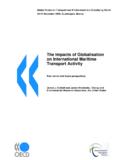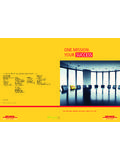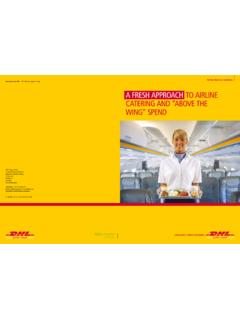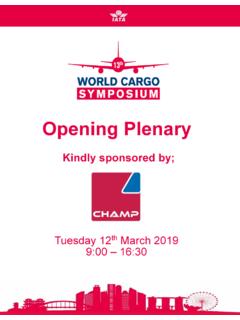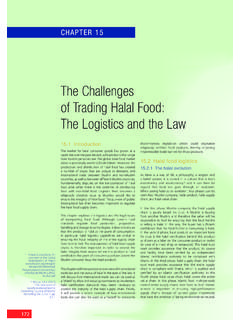Transcription of GREEN LOGISTICS: THE CARBON AGENDA
1 Copyright: Wy sza Szko a Logistyki, Pozna , Polska Citation: McKinnon A., 2010, GREEN logistics : the CARBON AGENDA . LogForum 6, 3, 1 URL: Accepted: , on-line: LogForum > Electronic Scientific Journal of logistics < ISSN 1734-459X 2010 Vol. 6 Issue 3 No 1 GREEN logistics : THE CARBON AGENDA Alan McKinnon Heriot-Watt University, Edinburgh, United Kingdom ABSTRACT. Over the next few decades European companies will come under intense pressure to cut their greenhouse gas (GHG) emissions in an effort to achieve very ambitious CARBON reduction targets at national, EU and global levels by 2050. This paper presents a framework for the decarbonisation of their logistical activities based on five key freight transport parameters: freight transport intensity, modal split, vehicle utilization, energy efficiency and the CARBON intensity of the energy used in logistics .
2 It examines the potential to cut GHG emissions by altering each of these parameters. Consideration is also given to the decarbonisation of warehousing operations. It is concluded that many of the GHG-reduction measures will also yield financial benefit. The decarbonisation of other sectors of the economy may, however, generate greater demand for logistics services. Key words: GREEN logistics , CARBON intensity, decarbonisation measures for logistics . INTRODUCTION Climate change is likely to become a major business driver over the next few decades as companies come under intense pressure to decarbonise their activities. There is general acknowledgement in government circles that the increase in global temperatures (above pre-industrial levels) must be limited to 2o C by 2100. This will entail a global reduction in CO2 emissions of 50% by 2050 (against 1990 levels), with some developed countries, such as the UK, already committed to an 80% reduction over this period [Committee on Climate Change, 2008].
3 To our knowledge no country has, as yet, disaggregated these national-level CARBON reductions into a series of sectoral targets. In theory these targets should be related to the marginal cost of CARBON abatement (MCCA) in different sectors. It is not known how the MCCA of logistical activities is likely to compare to that of other business activities. In absolute terms, however, the CARBON footprint of logistics is likely to be much smaller in 2050 than it is today. The World Economic Forum and Accenture [2009] have estimated that logistics accounts for around of global greenhouse gas (GHG) emissions and indicated how this is divided between freight transport modes and ' logistics buildings'. logistics ' GHG 'footprint' may appear relatively modest, though, unlike most other sectors, which have been reducing their GHG emissions, transport, and in particular freight transport, has been increasing its output of these gases.
4 On a business-as-usual basis, there trends are forecast to continue. Freight tonne-kms are predicted to grow at per annum between 2000 and 2050 partly as a function of the expansion of production and consumption, but also reinforced by an increase in the average distance that each unit of freight is transported [World Business Council for Sustainable Development, 2004]. Globalisation is lengthening supply lines, thereby increasing the freight transport intensity of the world economy. The amount of CO2 McKinnon A., 2010, GREEN logistics : the CARBON AGENDA . LogForum 6, 3, 1. URL: 2 emitted by each tonne-km of freight movement also appears to be rising as more CARBON -intensive transport modes, particularly airfreight and trucking, capture a greater share of the freight market [IPCC, 2007]. No separate forecasts exist for changes in the level of CO2 emission from warehousing and materials handling operations, though they may be closely correlated with those of freight transport.
5 Developing and implementing practical and cost-effective CARBON mitigation strategies for the logistics sector will therefore present a major challenge. This paper outlines the nature and scale of this challenge and examines the different types of measure that companies can adopt to decarbonise their logistics . DECARBONISATION FRAMEWORK FOR logistics As freight transport typically accounts for 80-90% of logistics -related CARBON emissions, it is hardly surprising that it is the main focus of CARBON -mitigation efforts. These efforts can be targeted on five key parameters [McKinnon et al, 2010]: Freight transport intensity: this is the ratio of freight movement (usually expressed as tonne-kms) to economic output. Freight modal split: this indicates the proportion of freight carried by different transport modes and can be expressed as the ratio of tonne-kms carried by more CARBON -intensive modes such as road and air to tonne-kms carried by greener modes like rail, barge, ship and pipeline.
6 Vehicle utilization: this can be measured by the ratio of vehicle-kms to tonne-kms, in other words how much vehicle traffic is required to handle a given amount of freight movement. If the vehicles are well-loaded on outbound and return journeys this ratio is minimized. Energy efficiency: defined as the ratio of energy consumed to vehicle-kms travelled. It is a function mainly of vehicle characteristics, driving behaviour and traffic conditions. CARBON intensity of the energy source: the amount of CO2 emitted per unit of energy consumed either directly by the vehicle or indirectly at the primary energy source for electrically-powered freight transport operations. The next six sections will examine the opportunities for altering these ratios. A later section will explore the options for decarbonising warehousing.
7 REDUCING FREIGHT TRANSPORT INTENSITY In much of the developed world, the growth of freight movement has been due more to each unit of freight being transported over greater distances than to the physical mass of goods in the economy expanding. This trend has been driven mainly by two processes, (i) the wider sourcing of supplies and (ii) the centralisation of economic activity. These processes cannot continue indefinitely. Eventually supply chains will become fully extended. International and inter-regional differences in production costs may also narrow, reducing the economic incentive to trade with distant suppliers and distributors. This 'market saturation' effect is likely to occur first at a national level and then at the level of continents / trading blocs and eventually the world as a whole. There is some evidence that in developed, mature economies such as the UK [McKinnon, 2007a], the expansion of sourcing / market areas is now at an advanced state.
8 At the continental and global levels, however, this expansion is continuing apace and even accelerating in some areas and sectors. The centralization of economic activity is also finite, as ultimately production and distribution facilities will reach their maximum economic size, though this process has still some way to run. Within developed countries, there is limited scope for further spatial concentration, but in much of the developing world, the process of centralization is at an earlier stage. McKinnon A., 2010, GREEN logistics : the CARBON AGENDA . LogForum 6, 3, 1. URL: 3 The long term increase in the average length of haul is largely a consequence of major global business processes which will be very difficult to reverse. Simulation modelling of logistical systems indicates that the cost trade-offs which companies make between transport, inventory and warehousing are very robust.
9 Tilting these cost trade-offs sufficiently to induce a return to more localised and decentralised patterns of production and distribution would require very large increases in freight transport costs. An emissions-trading price for CARBON or CARBON tax would have to be set at a high level to force a return to more decentralized systems, particularly in sectors producing higher value goods. Nor is there any guarantee that a move back to more localized sourcing or decentralized production and warehousing would yield a net reduction in CARBON emissions. Full life cycle analysis (LCA), which takes account of the CARBON intensity of production, storage and handling operations, is required to determine the pattern of sourcing that minimises CARBON emissions. Distant suppliers may operate more energy-efficient, less CARBON -intensive production facilities than local suppliers and the resulting saving in production-related CO2 may exceed the additional emissions from longer freight hauls, especially as, in many sectors, CO2 emissions from the production operation typically dwarf those associated with physically distributing the products.
10 To determine the net CARBON impact it is necessary to conduct a logistical trade-off analysis, similar to those long applied in the economic optimization of logistics systems, but now recalibrated with respect to CO2 emissions (Figure 1). Fig. 1. Optimising the number of warehouses in logistics system with respect to CO2 emissions Rys. 1. Optymalizacja liczby magazyn w systemu logistycznego w odniesienie do emisji CO2 SHIFTING FREIGHT TO LESS CARBON -INTENSIVE TRANSPORT MODES CARBON intensity (expressed as gCO2 per tonne-km) varies widely between transport modes (Figure 2). Shifting freight from modes with relatively high CARBON intensities, such as air and road, to those with much lower CARBON emissions, such as rail and water-borne services, can substantially decarbonise freight transport operations. As explained earlier, however, trucking and airfreight, the more CARBON -intensive modes have been increasing their share of the freight market in most parts of the world.



